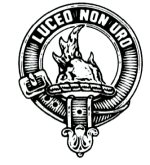
|
HOME CLAN HISTORIES SCOTTISH CASTLES SCOTTISH WEDDINGS ROBERT BURNS CONTACT |
 I SHINE NOT BURN Clan Crest © Art Pewter Silver Ltd, East Kilbride, Scotland |
 |
| It is believed that the Mackenzies hailed from Ireland, descended from the house of Geraldine. It is said that a large number of the clan moved to Scotland and helped Alexander III repel a Norwegian invasion and accordingly the Chief was granted the lands of Kintail. Colin Fitzgerald was the first feudal baron of Kintail.
In around 1352 Colinís grandson, Kenneth was granted a Charter by King David II. The name Kenneth is then believed to have become corrupted in English into Mackenzie. The Mackenzies are said to have risen on the ruins of Clan Donald, whose vassals they were. In 1427 their Chief already had a following of 2000 men. In 1447 King James III granted Alastair Mackenzie of Kintail extensive lands, including Strathcoman, after providing his support against the Macdonald of the Isles. Under his son Kenneth the expansion continued. Kintail was erected into a Barony in 1508. There is a stone effigy of Kenneth at Beauly Priory where he was buried. The Mackenzies continued to extend their lands in Ross, from the Black Isle to the Gairloch and from Kintail to Coigeach. Their Western stronghold, the castle of Eilean Donan, was usually held for them by the MacRaes. In the seventeenth century they built Brahan Castle near Dingwall, made famous by the prophecies of the Brahan Seer.The Mackenzies were staunch Jacobites and after the Rising of 1745 peerages were forfeited though later restored to them. To show his gratitude for their restoration, the 6th Earl set up the 72nd Regiment, the old Seaforth Highlanders. The present Chief, The Earl of Cromartie, descended from Sir Roderick Mackenzie of Coigeach, had to renounce his family name in order to inherit the title through the female line. He lives at Castle Leod in Strathconan. |